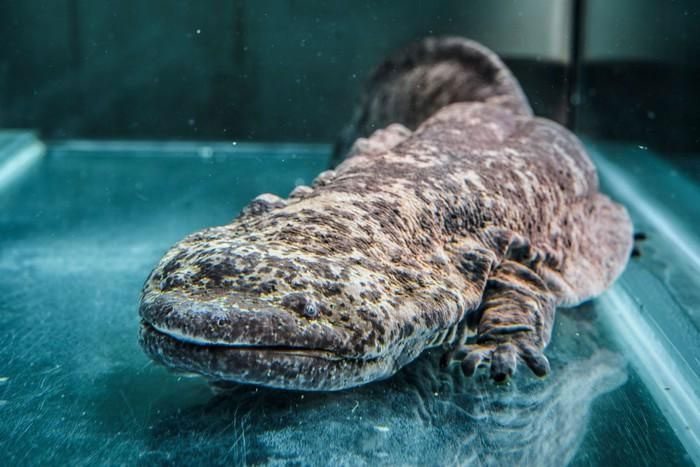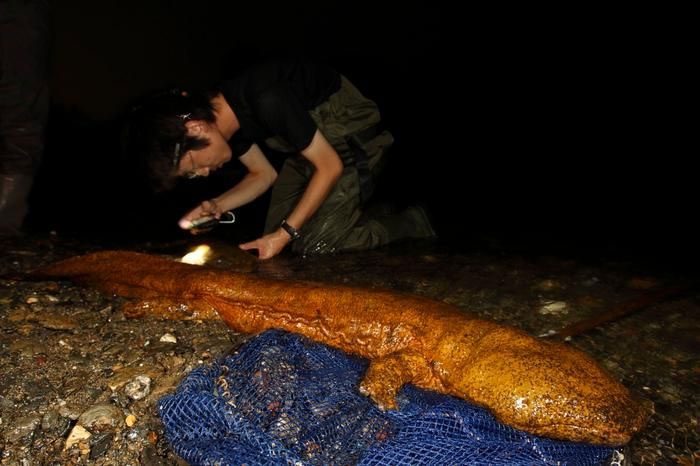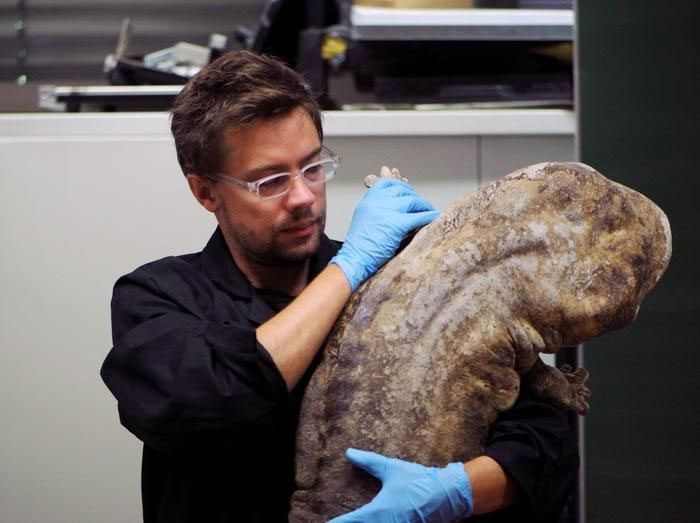The Chinese giant salamander is truly a “living fossil,” distinct and robust, unlike the common pet salamanders.
The Chinese Giant Salamander (Andrias davidianus) is one of the largest and most unique salamander species in the world. This amphibian originates from Central and Eastern China and can grow up to 1.8 meters in length and weigh nearly 60 kg, making it the largest amphibian still existing on the planet.

This species has a large head, small eyes, black and wrinkled skin. It is one of two surviving species in the genus Andrias; the other, slightly smaller but overall very similar, is the Japanese giant salamander (Andrias japonicus).
Historically, the giant salamander was considered a single species, but recent research has identified them as three distinct species from Southern, Central, and Eastern China.
One of the newly named species, Andrias sligoi, or the South Chinese giant salamander, is believed to be the largest of the three, reaching lengths of nearly 2 meters.
The Chinese giant salamander, unlike many other amphibian species, has a long lifespan, with some individuals potentially outliving an average human.
They can live up to 30 years in the wild and even up to 60 years in captivity. The difference in lifespan between wild and captive Chinese giant salamanders stems from their diet and living conditions. While wild salamanders must fend for themselves and face illnesses and numerous threats, captive salamanders benefit from medical care and protection from predators.

The Chinese giant salamander feeds on insects, frogs, and fish. It has very poor eyesight, relying on sensory nodules along its body to detect vibrations in its environment.
In nature, these giant amphibians can be found in a variety of habitats, including rivers, lakes, and caves. They are also known to inhabit underground rivers. In some regions of China, only underground populations remain, as the surface populations in rivers and lakes have been overharvested for their eggs.

The Chinese giant salamander is known to produce sounds, such as barking, whining, and crying. Some of its vocalizations resemble a child’s cry, leading to its nickname in Chinese as “oa oa ngư,” meaning “child fish.”
The Chinese giant salamander is an extremely endangered species and is considered one of the most threatened amphibians in the world. This is due to habitat loss and degradation, as well as overexploitation for medicinal use and food. In recent years, wild populations have severely declined, and the species is currently estimated to exist in very low numbers in the wild.
On the other hand, there are about 2.6 million giant salamanders being farmed in Shaanxi, China, far exceeding the estimated wild population of under 50,000 individuals. Currently, giant salamander farms are “struggling” to produce hybrids of this species to meet market demand.

The Chinese giant salamander is an aquatic animal and lives in rocky streams or clear lakes. It is often found in dark mud or rocky crevices along rivers, lakes, ponds, and streams in broadleaf and coniferous forests. It is primarily found in forested areas at elevations ranging from 100 to 1,500 meters, with the highest frequency of sightings recorded between 300 and 800 meters.
Despite being an amphibian that lives entirely underwater, the Chinese giant salamander still possesses a lung, primarily used to maintain buoyancy in the water.
However, this lung can also be used for breathing on land, as this species has been observed surfacing to breathe air. This makes it one of the few salamander species capable of breathing through both skin and lungs, allowing it to thrive in both aquatic and terrestrial environments.

The Chinese giant salamander was once widespread in Central, Southwestern, and Southern China, but its range has now been greatly fragmented. Females of this species typically lay 400-500 eggs in an underwater nest, after which the males will guard the nest until the eggs hatch after 50-60 days.
The Chinese giant salamander has small eyes that are almost invisible on its head, and its eyesight is also very poor. However, to compensate for its poor vision, it has sensory nodules on either side of its body that help it locate fish in the water.
Additionally, the Chinese giant salamander is considered a “living fossil,” having changed little in shape over millions of years, making it an important species for understanding the evolutionary process of amphibians.
In China, the government has established conservation areas and banned the harvesting and trade of wild individuals. Furthermore, breeding and release programs have been initiated to help increase the population of this species in the wild.


















































